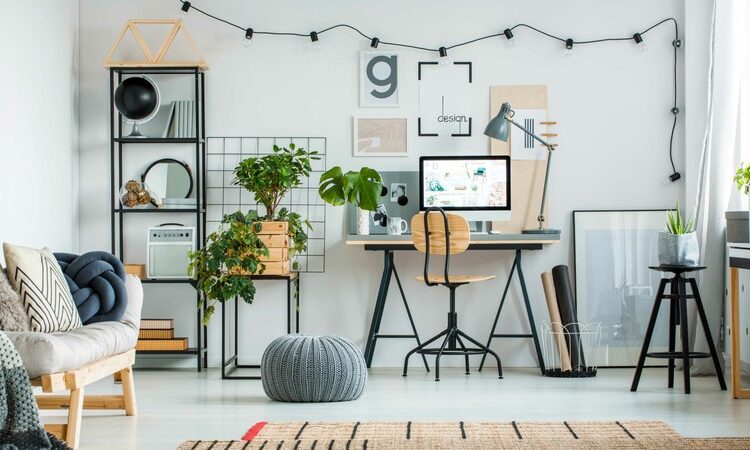How to Design a Home Office That Inspires Productivity
You know how important it is to create a home office that motivates you to get things done if you work from home, whether full-time or part-time. The ideal home office is one that is both relaxing and conducive to getting work done (i.e., you won’t be as productive sitting on the couch as you would be at a desk). After relocating into a new home, there is no better time to begin the process of creating your ideal living environment. Read on for advice on how to set up a home office that has all the advantages of a productive workplace without the hassle of commuting, whether you’re just getting started or want to spruce up the space you already have. (Although it is still your responsibility to remember to get dressed each day.)
Separate the space
You should first ensure that your home office is physically separated from the area in which you perform your daily living activities. Two reasons make this crucial. For one, it helps your mind transition from “home” to “work” mode when it’s time to get to work and vice versa when it’s time to go home. Second, having everything in its own compartment will make it easier to maintain order and will relieve you of the burden of daily tidying. It is important to remember that a private office doesn’t have to be located in a separate room. It’s not necessary to have a whole room set aside as an office; many people make do with a single chair at the dining room table, which they then have to clear off before they can use again. Keep to the same spot in your house that you’ve designated as your office. The more time you spend in a given workspace, the easier it will be to switch into work mode when the need arises.
Get rid of distractions
You are the best judge of what will distract you from your work, so you should eliminate any potential sources of distraction from your immediate working area. Maybe it’s the proximity of the fridge to your preferred viewing and gaming setup. In fact, some people are so easily distracted by the scenery outside that having their desk facing a window is counterproductive. The location of your home office is secondary to the deliberate decisions you make when setting it up. If you find yourself most productive in the kitchen or living room, where interruptions are common, set up your workspace so that you don’t have to keep tearing your focus away from your work. Even better, if you can afford to have a separate room set aside for work, you should keep it free of distractions.
Invest in the things that matter
Having the proper equipment in your home office is the first step to maximizing efficiency. This entails having access to a relaxing chair, a spacious desk, and any necessary tools for doing your best work. Prioritize the things that will help you get the most work done when figuring out how much money you need to set aside for a home office. You should make sure that this area serves all of your needs, as you will be spending a lot of time here. If you want tp look at luxury furniture for your space, check out Slingo.com for a list of luxury furniture brands.
Add in some orange…
According to Feng Shui, the color orange represents concentration, efficiency, and order. The more vivid the color, the better. Even if you don’t want to go as far as painting the whole room orange, simply adding a few orange accessories like a lamp or vase can help trick your brain into being more productive.
…and some green
Plants and flowers on a desk have been shown to increase concentration and productivity, according to research from Norway. The exact causes and explanations of this phenomenon are still up for debate, but one theory suggests that it has to do with the fact that natural objects can serve as a brief diversion from one’s work without being too distracting. Having a plant on your desk or elsewhere in the room is good for your brain and an essential part of an efficient home office, but the exact mechanism by which this occurs remains unknown. Make sure the plant stays healthy, as a dying or dead plant could be more of a visual disturbance.
Don’t forget about storage
A well-planned home office will include ample storage space. Even if you do most of your work on a computer, you’ll still need a designated area to store paperwork, files, and other office necessities. If you want to be productive in your home office, you need a place to put things that don’t need to be out on your desk all the time, such as a filing cabinet, chest of drawers, or some other solution. Clutter can cause mental stress and hinder productivity, so it’s best to take care of it instead of letting it build up.
Pay attention to lighting
It’s important to have adequate lighting in a home office, both for the sake of atmosphere and so that you can see what you’re doing without straining your eyes. Pay close attention to the lighting, concentrating on the spots where you’ll need to see the most. And remember that too much illumination is never a bad thing; in fact, it’s preferable to the alternative. Floor lamps are a great alternative to ceiling lights for illuminating a room. And don’t forget to brighten up your primary workspace by placing a table lamp on your desk. Even if you prefer warmer lighting, such as yellow bulbs, research shows that “cool” light (white bulbs) are better for clarity of mind and maintaining concentration.
Keep your to-do list front and center
Keeping on track while working from home requires some strategic planning. Many people find that having a visual representation of their to-do list is an indispensable aid in monitoring their progress and ensuring that everything gets done. Keeping your tasks in sight is helpful even if you use an app to keep track of them. You can either use a desk calendar to list your daily tasks or a wall calendar to keep track of your commitments. Not only will you be less likely to forget something important, but you’ll also have a better idea of how your day is shaping up, which is especially helpful when your working hours are fluid.
Control the temperature
It’s important to make sure you’re not too hot or too cold in the office, as either extreme can be a major source of distraction. Even if you can’t change the room temperature exactly, there are still things you can do to make it more comfortable. Hang a sweater or blanket over your chair and use a space heater if the room is chilly. Keep a fan on your desk and drink lots of cool water if the room temperature is high. Maintaining a consistent internal temperature will assist in keeping you calm and alert. If you work from home, your office space should be somewhere you enjoy spending time. When working from home, you have more freedom to design an environment conducive to productivity than you would in a traditional office. Toggling work mode on and off as needed will become that much less of a hassle.











